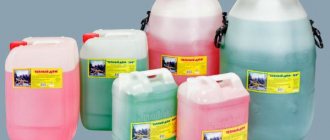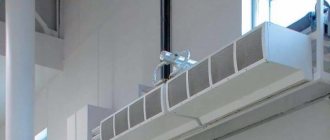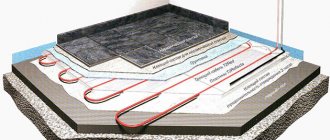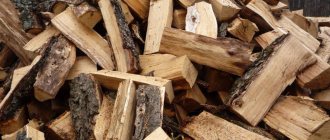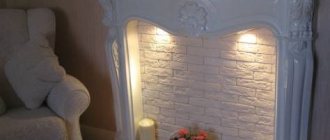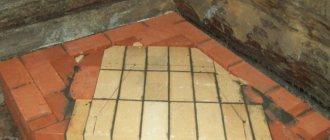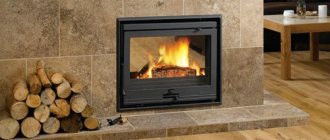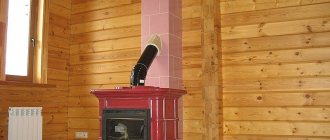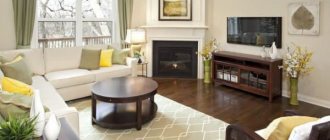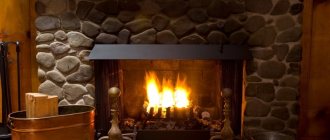Recently, the construction of a fireplace in the country has gained particular popularity. After all, this multifunctional product allows you to enjoy natural warmth; its crackling has a beneficial effect on the nervous system. In addition, it can become a real home decoration. Who doesn’t dream of enjoying the comfort of radiated heat on cold winter evenings? But in order for it to fit perfectly into the interior, it is necessary to carefully select its external decoration. Surely, many are interested in how to decorate a fireplace on their own, while creating harmony and comfort. Today there are many options for finishing a fireplace. Cladding a unique fireplace with your own hands, step-by-step instructions for which are presented below, allows even an inexperienced owner to become the happy owner of a beautiful piece of furniture.
Joining seams - a simple finishing method
After the fireplace is built, it is imperative to fill out the joints. To carry out this type of work, it is necessary to evenly distribute the solution between the masonry elements using a special device. The seams can have a depressed or convex shape. It depends on the individual wishes of the dacha owner. Today, very often a special pigment is added to solutions, which can color the substance in any shade. This allows you to create an original design that fits perfectly into the design. To fill the seams you will need:
- hammer-pick;
- trowel;
- special jointing for creating convex or concave seams;
- spatula for applying the solution.
Instructions for performing the work:
- formation of horizontal seams;
- formation of vertical seams;
- cleaning the masonry with a special brush consisting of natural fibers;
- application of a special paint and varnish substance that is resistant to high temperatures.
All work should be carried out very carefully. It is strictly forbidden to clean the masonry with a brush with coarse wire bristles, as it can ruin the appearance by causing scratches. Anyone can do this type of fireplace design with their own hands.
Finishing the fireplace with plaster
Decorating a fireplace with your own hands using plaster is the simplest and, at the same time, inexpensive way to create beauty and comfort. With its help you can create the most incredible scenery. For example, applying the plaster mixture with a sponge will give it a peculiar waviness. You can also add pigment to the finishing mixture and thereby color it in the desired shade. So, after the masonry has dried, you can safely begin plastering:
- Add finely chopped fiberglass and table salt to the prepared plaster mixture. This will improve the quality of the coating;
- clean the surface of the masonry and seal the seams evenly to a depth of 1 cm;
- heat the fireplace for better distribution of the plaster and its uniform drying;
- moisten the surface of the fireplace with a spray bottle;
- apply the first ball of plaster mixture using the “spraying” method;
- ensure that the first ball is completely dry;
- apply the finishing ball of plaster.
Applying the finishing layer requires special attention. Using a trowel or brush, apply the mixture, distributing it evenly over the surface. You can eliminate unevenness using a special grater, which should be worked in a circle. The thickness of the ball should not exceed 0.5 cm.
Using drywall to decorate an electric fireplace
When performing this type of design, you should first arrange the frame. It should be installed with precise calculations. That is, vertical frame racks should allow the drywall to be securely fixed, but at the same time its joints should be neat and invisible. The fastening of plasterboard sheets should be carried out strictly along the frame. Fixing them between profiles is strictly prohibited. Thus, decorating a fireplace with your own hands using plasterboard includes the following steps:
- clearly plan the design;
- Apply only visible marks to the surface for attaching profile elements. Marking should be done evenly, clearly and at the same distance;
- secure the vertical profiled frame according to the marks. For this type of work, ordinary screws are suitable;
- installation of horizontal frame elements;
- use plasterboard sheets to sheathe the frame. For fixation, use self-tapping screws, which are fastened at a distance of no more than 150 mm from each other;
- seal drywall joints using a special tape soaked in gypsum mortar;
- install the corners - this will not only give expressiveness to the shapes, but also ensure the strength of the structure;
- carry out external decoration. Drywall can be decorated in a variety of ways, including plastering.
Installation of drywall is not a complex type of work and does not require special equipment. For this type of work you only need a screwdriver, which can be found in every home.
Furniture and interior items
70 votes
+
Vote for!
—
Vote against!
A fireplace designed according to all the rules will regularly provide warmth and fill the surrounding space with home comfort. But in order for this popular interior element to perform another function, an aesthetic one, it is necessary to choose a suitable finishing option. Moreover, facing a fireplace is an activity that will not only bring a lot of positive emotions, but also provide a unique opportunity to make the dream of the most beautiful fireplace come true. Don't be afraid to experiment and bring original ideas to life!
Content
- Materials for facing the fireplace
- Plaster
- Drywall
- Natural and artificial stone
- The most popular cladding options
- Ceramic tile
- Tiles
- Fireplace lining: photo selection
- Fireplace lining: video
Materials for facing the fireplace
The options for covering a fireplace are so varied that if you wish, choosing a decor that harmoniously matches the style of your home will not be difficult. Choose the material that you like best and... start creating!
Plaster
Plastering a fireplace is the simplest method of cladding, which, however, should not be discounted. Using ordinary plaster you can create a lot of decorative effects. For example, apply the finishing layer with point movements with a sponge or use a rubber spatula to create an attractive “waviness”. Lightly tinting the solution with lime or water-based paints will enhance the result.
Plastering is carried out after complete drying and shrinkage of the masonry. To ensure a high-quality coating, salt and finely chopped fiberglass are added to the plaster. The surface of the fireplace is cleaned, the seams are cut to a depth of 10 mm. The fireplace must be warm, so heat it before plastering. Then moisten the masonry and begin to apply the first layer using the “spraying” method.
The second layer (covering) is applied with a brush or trowel and leveled with a grater. The thickness of the covering layer should not exceed 5 mm. Leveling is done in a circular motion; if necessary, the surface can be sprinkled with water.
Drywall
You can cladding a fireplace with your own hands using plasterboard, which is attached to a metal frame. When installing vertical racks, pay attention to the joints between the plasterboard tiles - they must be neat. The slabs are connected only at the vertical and horizontal elements, and not between them (as many believe). Before installation, the mounting points are marked on the wall, floor and ceiling, the verticality of the racks is controlled using a plumb line and a ruler.
The racks are secured with screws, and horizontal frame parts are installed between them. Plasterboard boards are screwed with screws at intervals of 15 cm. The joints are sealed with tape soaked in gypsum mortar. The corners are fixed with metal corners. That's all. All that remains is to plaster the cladding.
Natural and artificial stone
If you are looking for an answer to the question of how to make a fireplace cladding luxurious and sophisticated, then natural stone will be your best assistant in this matter. Natural splendor leaves no one indifferent; natural beauty captivates with its variety of solutions and quality for centuries. Due to the fact that prices for fireplace cladding increase every year, the desire of many to master the secrets of ancient craftsmanship is understandable. Well, nothing is impossible.
If you have specialized equipment, you can use granite or marble for the work, but if this is not observed, then rubble stone, limestone, and shell rock will be the solution for connoisseurs of nature’s gifts. For fastening, use tile adhesive or mastic. After facing, the stones are varnished, which not only improves the appearance, but also makes it easier to maintain the surface.
Artificial stone is no different in beauty from natural stone, which means it is one of the worthy candidates for decoration. Lovers of handmade products will love the following recipe for making “stone” at home. Prepare a mixture consisting of river sand, cement and coloring pigments and pour it into silicone molds. After a few hours, the resulting pebbles can be used for decoration.
The most popular cladding options
Today there are two most popular options for facing fireplaces. This is ceramic tile cladding and tile cladding. Let's look at the features of the technology and try to find out what is the secret of its incredible popularity.
Ceramic tile
Cladding with ceramic tiles does not present any particular difficulties and is completely within the power of anyone. The main thing is to choose high-quality materials and adhere to a certain sequence of work. Most often used for decoration:
- porcelain stoneware;
- terracotta (unglazed tiles);
- majolica (pressed glazed tiles with a pattern);
- clinker tiles.
The above samples are distinguished by mechanical strength, high wear resistance, presentable appearance, and resistance to high temperatures.
When choosing, consider the size of the tiles - large specimens are easier to lay, but more difficult to fit under ledges, niches and shelves. The correct choice of adhesive is of no small importance - purchase heat-resistant bases containing elastic substances that prevent temperature deformation of the adhesive layer.
Work begins with preparation - cleaning and deepening the seams. If the fireplace has previously been painted, then the old coating must be cleaned off with a metal brush or the surface covered with a mesh with cells no larger than 15x15 cm. It is recommended to secure the mesh with nails or self-tapping screws. Next, you need to level it with glue. It is allowed to proceed directly to the cladding only after final drying.
We mark out the area with a level, plumb line or level and start working from the bottom row. Apply the glue with a notched trowel, press firmly to the surface and tap with a rubber mallet to be sure. The consistency of the gaps will be ensured by plastic crosses, two on each vertical and horizontal side of the tile. Remains of glue are removed immediately after cladding, because it will be impossible to remove it later. We start grouting after 24 hours (read the glue label for more details about the hardening time).
We fill the seams with paste-like cement-based mineral grout and carefully level them with a damp sponge. The next day we treat the seams with a dirt-repellent compound.
Tiles
Tile cladding, practiced for centuries, has not lost its charm today. A fireplace decorated with majolica or terracotta tiles looks original and fresh. Tiles can be matte, glossy, with relief or pattern.
The difference between tiles and conventional ceramic tiles is the presence of a rump - a box-shaped protrusion. Using a pump, the tiles are attached to the surface of the fireplace, accumulating heat and ensuring effective heat transfer. Before cladding, carefully inspect the material: samples from the same batch may differ slightly in color. Next, use a grinder to adjust the parts to the same size. The tiles are secured to the fireplace surface using wire inserted into the holes in the tiller.
We fill the tiller halfway with a mixture of clay and broken bricks and insert a crutch into it (a piece of wire with a diameter of 5 mm with an upward bend). We tie a soft wire to the middle of the crutch (which will later be embedded in the brick joint of the masonry), fill the tiller with building mixture to the brim. Then we lay the tile, press it tightly and hide the wire in the seam of the masonry. The tiles communicate with each other using U-shaped brackets.
As you can see, covering a fireplace with your own hands is a process that has certain subtleties. Although, if you have the desire, this nuance is unlikely to stop you. If you haven’t made your choice yet, the photo selection below will help your dreams take on some form. Which one? You decide!
Fireplace lining: photo selection
Fireplace lining: video
Sale of natural stone in St. Petersburg at affordable prices. Coil stone will decorate any landscape design. Natural stone also looks expensive and beneficial in any design.
Using stone to decorate a brick fireplace
Finishing with natural stone allows you to make the fireplace especially refined and chic. Natural material, like no other, fits into any room design, allowing you to emphasize the nobility and sophistication of the owner. In addition, natural stone has unique performance characteristics. With special equipment, you can create real masterpieces of art. If you do not have devices for processing natural stone, then you can use shell rock, limestone, and rubble stone. Such a DIY fireplace will become the pride of every home owner. You can also use artificial decorative stone to decorate the fireplace. It looks similar to natural material, is easy to install and has a long period of use without losing its appearance.
Modern technologies make it possible to select an artificial material to match any natural resource. In addition, you can make artificial stone yourself. To prepare a mixture for making stone, you need to mix cement, sand and pigment. Pour the finished mixture into special silicone molds and leave for a certain time until it hardens completely. Remove the finished artificial stones from the mold. They are ready for facing work. Carrying out cladding work with both natural and artificial materials is done in exactly the same way: using a special adhesive for ceramic tiles, you need to fix the stones on the surface of the fireplace. To create a beautiful pattern, stones can be laid out on a flat surface, choosing the most advantageous options for their placement. Thus, when they are fixed already on the surface of the product, there will be no troubles associated with size or shape.
Tiles for facing fireplaces
A very popular way of decorating is tiling fireplaces. The modern market offers a huge range of this material, which allows you to make the best choice, taking into account the design style, your tastes and preferences. Sometimes ordinary tiles are used for cladding. But experts prefer fire-resistant types of material.
Fireplace tiles can be:
- ceramic,
- porcelain stoneware,
- glass,
- from natural stone,
- from artificial stone.
The material differs not only in the type of raw material, but also in texture. Tiles can be smooth, matte, rough, textured. This finish has various sizes and shapes, allowing you to use one type of material or lay out mosaics, patterns and panels.
Tiling uses a special adhesive that does not change its properties when exposed to elevated temperatures. This material creates excellent adhesion and allows even heavy stone material to be firmly fixed.
A fireplace lined with tiles has high aesthetic values. But this type of cladding has quite high requirements for surface preparation and installation. Therefore, cladding work should be entrusted to professional craftsmen.
Tiles for fireplace cladding
One of the most difficult types of decoration is facing fireplaces with tiles. These tiles with relief images have a specific type of fixation. Such decoration can only be created during the process of laying the fireplace. Special metal brackets on which the elements are fixed are placed in the seams.
Despite the high cost of the material and work, there are many who want to create such a fireplace decor. Tiles:
- transform the design into a unique masterpiece;
- fit harmoniously into respectable interiors;
- increase the efficiency of heat transfer, thanks to the cavities inside the tiles.
Such cladding, made by a qualified craftsman, will retain its original appearance for many years.
Types of fireplace lining
There are several types of cladding, which are selected depending on the type and style of construction:
- portal;
- wall;
- corner;
- island;
- stove
The classic way to design a structure is to create a portal in the shape of the letter “P”. Its frame can be stone or wood. In most cases, this form of cladding is used for built-in structures of the classical style. The firebox can be of any size, open or closed.
It is not always possible to install a fireplace in the wall. Wall structures are made more often. Their cladding can be done in any desired style. The most popular are rustic and modern.
Corner fireplaces are installed in small rooms and save space for the fireplace. These models can provide a large viewing angle of the firebox.
Nowadays, admirers of original interiors prefer to create island fireplaces in living rooms. In them, the cladding can provide panoramic, three- or two-way visibility.
Thanks to the increased interest in rustic and country styles, stove-style fireplaces are increasingly being seen in modern homes. For such structures, materials are selected that can provide a beautiful appearance and retain heat.
Fireplace mantle styles
Many different design styles are used in the design of houses and apartments. In accordance with them, the type of cladding is selected. The main options are:
- classic,
- rustic,
- modern,
- high tech.
In the classic design of a fireplace, a U-shaped portal is created, in which natural stone or specially treated wood is used. The traditional option for such fireplaces is an open firebox lined with stone or brick. Forged cast iron gratings, clones, carvings, bas-reliefs or sculptures can be used in the decoration of the portal.
Rustic style is also called rustic or country. The main advantage of this design is maximum comfort, which only a real home can create. The cladding can be made entirely of wood or this material can be combined with stone or metal. Usually the firebox is framed in the shape of the letter “D”, with a shelf on the bottom crossbar, a niche for logs.
Modern man simultaneously strives for something new and tries to be closer to nature. These features are reflected in the Art Nouveau style. For the cladding shape, a rectangle or semicircle is usually used. Not only the surroundings of the furnace are designed, but also the chimney casing. The cladding uses polished stone slabs, glass, and stainless steel.
Classic materials, such as stone and wood, are practically not used in high-tech cladding. Stainless steel and fireproof glass reign here.
Professional craftsmen are able to complete any fireplace cladding, provide its appearance with absolute harmony, and select types and shades of elements in full accordance with the interior features of the room.
( 1 votes, rating: 5.00 out of 5)
Using tiles as a fireplace finish
Cladding a fireplace with tiles is one of the most popular design options. Experts recommend using tiles:
- clinker, with which traditional designs are created;
- majolica, which has a glazed surface with a pattern applied;
- terracotta, impressive with its matte finish;
- porcelain stoneware, having a variety of shapes and decorations.
In addition, these decorative elements have increased heat resistance. They will last a long period without losing their pristine beauty. When choosing tiles for finishing a fireplace, special attention should be paid to its size. Naturally, large tiles are installed very quickly, but they are more difficult to adjust to the size of shelves and niches.
Small sizes are easier to install in this regard, but finishing the cladding work will take much longer. Special attention should be paid to purchasing the adhesive mixture. It must be heat-resistant, elastic and provide reliable fixation. Execution of facing works includes:
- performing preparatory work, including cleaning and deepening the seams. Particular care should be taken to remove the old finish, if any;
- leveling the surface. To do this, apply the adhesive mixture in an even layer and allow it to dry;
- marking the surface of the fireplace;
- installing tiles starting from the bottom. To do this, glue is applied to the tiles. Next, the facing material is placed evenly on the base and tapped using a special rubber hammer. To create straight lines, it is recommended to use special plastic crosses, which can be purchased at a hardware store;
- removing protruding glue. This must be done while it is not yet frozen, since then it will be very difficult to cope with such work;
- allowing time for the glue to dry completely;
- Grouting joints using paste-like mineral grout. It is recommended to fill the seams evenly; using a damp sponge you need to level their surface;
- time for the fireplace to dry;
- covering the seams with a special agent that will repel dirt and dust.
You can veneer a fireplace at any time of the year, but it is best to do it from spring to autumn.
DIY cladding
The best instruction, of course, will be a video where you can see all the little details of the installation with your own eyes. We will try to convey this to you now in text form. The list of materials is small, and, most importantly, does not require you to invest huge amounts of money. These materials are sold at any hardware store. Before starting work, you should stock up on: self-tapping screws, a fireplace grate, a metal profile, galvanized sheets, as well as plasterboard (preferably moisture-resistant) and heat-resistant cotton wool. The latter must withstand temperatures of at least 700 degrees . The preferred thickness is about 3 cm .
We cut the profile in such a way as to make a contour around the existing firebox. You need to leave a small gap for air in/out, which will then be covered with grilles. They are located above and below the cladding. It should look something like this:
When the frame with gratings is ready, it can be sheathed with galvanized sheet . This must be done from within the profile. Next, cotton wool is placed (we do not recommend using foiled cotton wool due to the fact that it can emit an unpleasant odor when heated).
This is due to the fact that the foil is “glued” to the cotton wool by a certain material. This “glue” loses its properties over time, and also smells noticeably when heated. If you still decide to use it, then turn the cotton wool with foil not towards the fireplace, but towards the drywall. Thus, the binder between the cotton wool and the foil will “burn out” much more slowly.
It is better to choose non-foil cotton wool , which can withstand high ( up to 750 degrees Celsius ) temperatures. Next comes the drywall, which you can now design as you wish. Basically, that's all the work is. It seems that it is not difficult, but only if you have done similar things before. It’s quite difficult to calculate everything the first time. Something definitely won't add up.
The use of special finishing tiles
Tiles allow you to create an original and unusually beautiful appearance of the fireplace. They can be used in different shapes and sizes. Today, specialized stores offer a choice of glossy and matte decorative elements, with printed patterns and plain ones, with a relief and smooth surface. Externally, the tiles resemble tiles, but their reverse side has a special box-shaped protrusion - a rump. In addition to creating a beautiful appearance, tiles help to increase the heat transfer coefficient of the fireplace and retain heat for a longer time.
- Step 1 Prepare the material by carefully examining it. Tiles from the same manufacturer may have external differences. Next, you should arrange the finishing elements, putting them into a beautiful harmonious pattern.
- Step 2 Measure the tiller on each element and, if necessary, adjust it to the same size.
- Step 3 Level the surface and apply the solution.
- Step 4 Fasten the elements using wire. To fix it on the surface of the fireplace, the pump should be filled with a mixture of clay and pieces of brick, combined in equal proportions. Insert a tiller into the holes; as a rule, a wire with a diameter of no more than 5 mm is used for this. The edges of the wire should be bent upward. Place the finished tile in the original pattern and press it to the surface. Hide the ends of the wire in the solution.
Advantages and features of fireplace linings
Fireplace lining has a number of its own unique advantages and features, which you can read more about in our article:
| Photos of fireplaces with linings | Characteristics and Features | Detailed description |
| Fire resistance | Since the cladding is often made of solid fuel stoves, in the hearth of which a real fire burns and they are capable of not just heating up, but heating up to the highest possible temperatures, all cladding materials used are necessarily characterized by a high degree of fire resistance. At the same time, they must be able to withstand sudden temperature changes well. | |
| Environmental friendliness | Each material is an environmentally friendly product that does not emit harmful or hazardous substances or decomposition products when exposed to high heat. Tiles are the most durable and natural, as they are based on clay. The lining of stoves and fireplaces made with natural stone is highly valued; artificial stone is cheaper and more accessible; it also contains some natural components, their crumbs. | |
| Versatility | Claddings can be used not only for solid fuel heating units, but also for gas stoves, bio-fireplaces, and false fireplaces. For fastening and fixing, suitable mixtures and adhesive bases are selected with a thermal mark and a maximum temperature designation from 800 to 1200 degrees. | |
| Durability | Since all materials and coatings are environmentally friendly, natural and fire-resistant, therefore, they will last a very long time, and are guaranteed not to lose their original appearance, will not deform, crumble, and cracks and chips will not form on the surface. In order to maximize the service life, it is important to follow all rules regarding the care and safety of the equipment. |
The fireplace insert is lined not only for brick stoves, but also for modern fireplaces based on steel and cast iron.
In addition to all the above advantages and characteristic features, linings for stoves, fireboxes and fireplaces have a large and varied color palette, they are presented in various styles and designs. Both classics with patterns and ornaments, as well as more modern designs, are popular; the surface of such materials is often plain, matte, glossy or mirrored. You can purchase materials with a certain texture, the required shapes, sizes, colors, and combine them with each other.
You may be interested in reading this article from our thematic blog: “Thermofor stoves and fireplaces made in Russia.”
Use of wood – natural and elegant
Cladding a fireplace with your own hands using natural wood is not a difficult task. This natural material makes it very easy to create sophisticated designs. Any species is suitable for finishing, but you should still give preference to strong and durable wood. It is not the main decoration. Using wooden elements, you can give, for example, a plastered product a special touch of nobility. Wooden shelves will decorate any fireplace and perfectly match the interior of the room. When using natural wood, it is recommended to use special heat-resistant impregnations. They will allow the natural material not to react to high temperatures. The wood can also be treated with special paints and varnishes to give it a perfect look. Whatever finishing method is preferred, it is worth taking care to create a harmonious design of the entire room. After all, the fireplace is part of the room, exquisitely complementing it, providing comfort and coziness.
Article Rating
